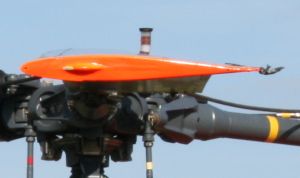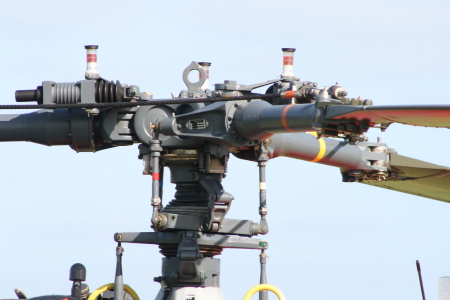The main rotors give the helicopter its lifting and control force. The lifting force
is orthogonal to the rotordisc (upwards). By tilting the rotordisc, the direction
of the lifting force is controlled. Each rotor individually adds to this force. When considering the rotors, a second important force comes into play immediately: rotordrag. This operates parallel to the orientation of the rotordisc,
and in the opposite direction of rotor movement. This force must be overcome by
the engine.
Rotors give the helicopter its lifting capacity in much the same way as wings do
for an airplane. The rotors can be viewed as rotary wings (helicopters are, indeed,
often classified as 'rotary wing aircraft'). In contrast to fixed
wings, rotors are much thinner and more flexible and, due to the high rotational speeds they achieve, the structural forces upon them are significant. Rotors must be able
to cope with these. Another important aspect of rotor design requires account to
be taken of the fact that they move about a lot. This movement is not only in the
plane of rotation, but the rotors also lead and lag in this plane and flap up and
down.

Rotor designs use different profiles, and they can be constructed in many different ways. The
same holds true for the materials used. A common design is the use of a symmetrical profile
with a D-shaped extrusion, with the remainder of the chord made up of thin sheet metal comprised of an aluminium honeycomb.
Nowadays, composite materials are frequently used,
again because of their combination of strength and low density, together with their good damping qualities
The rotorhead is the result of a very complex engineering effort. Its purposes are to control the amount of lift generated by the rotors, and to provide
direction control by tilting the rotordisc. Both of these tasks are accomplished
by changing the rotorblade’s pitch. The amount of lift is controlled by changing the
blade pitch of all of the blades simultaneously by the same amount. The control that the pilot uses
for this purpose is called the collective. Direction control, by tilting the rotordisc, works by changing the blade pitch of
each blade individually. The amount of pitch now depends upon its position
in the circle of rotation. The control used by the pilot in these circumstances is called
the cyclic.

The collective and cyclic pitch settings are transferred from a stationary
mechanical system (the helicopter) to a rotating one (the rotating rotors). This
is carried out by a device which is constituted of two discs, called swash-plates.
One swash-plate does not rotate and is called the stationary swash-plate, whereas
the other does (with the main rotors).
The two plates are connected to each other with a bearing. The input
controls are connected to the stationary plate. The control rods which connect
to the blades (in order to set the desired pitch angle) are connected to the rotating swash-plate.
In this way, mechanical control input is transformed from the stationary to
the rotating rotorsystem, where the desired blade angles are realised.
As a result of various physical laws, the rotorblades tend to lead, lag and flap up and down.
This results in very high moments
and forces in the rotorhead construction at the position where the rotors are attached
to the main shaft. There are several different designs of rotorheads. One of these
uses
hinges to prevent the moments from being transferred to the shaft, and in another,
the resulting
forces are absorbed by elastic materials. Furthermore, a rotorhead must be able to withstand
the high centrifugal forces placed upon it by the high angular velocity of the rotorblades.
An important property is the total mass of the rotorblades since
this is a measure
of the amount of kinethic energy stored in the system. A significant
amount thereof makes the rotorsystem less vulnerable to low rotor RPM because it takes longer
to slow the blades down.
Next topic > Engine & Transmission
|
Cyclic & Collective
- The title of this book leads me to wonder what more it will teach me in addition to its content about these two, most frequently used, helicopter input controls. As it turns out, the answer is: a lot more. Of course, all of the obligatory subjects like basic physics, rotor aerodynamics and helicopter performance are dealt with as well, as are piston engine and basic helicopter manoeuvres. Yet the scope of this book is actually much wider than one might initially think.
Firstly, it is divided into a 'beginners’ and an 'advanced’ section. This means that the book can treat more complex concepts in depth, even though the focus in the first section is directed more towards newcomers to the field.
Secondly, subjects like turbine engines, multi-engine helicopters and autopilots are also examined. This is particularly helpful, since these topics are not usually covered in the majority of helicopter books aimed at this target audience.
Thirdly, the book deals with many things that you will not normally find in a text book: helicopter related experiences and a great deal of interesting detail. This is the sort of information that can only be provided if you have flown a lot of different helicopters and have been working in this industry for some time. What’s more, this tone is amplified by the consistently narrative style of the book.
- 536 pages
|
|
Art of the Helicopter (Hardback)
- Well structured text that covers many technical aspects. It starts with an introduction to helicopters, followed by a treatment of
the technical background needed when studying them. Thereafter, dynamics, rotor systems, engines and transmission are explained in detail.
The book concludes with a section on performance and other types of rotorcraft. Its main asset is that the text is technically and
theoretically very accurate, and rather than mathematics, its focus is always on enabling the reader to achieve an understanding of
helicopters from a technical or engineering point of view. The more technically orientated reader will love this work.
- 416 pages
|
|
Principles of Helicopter Flight (Paperback)
- If you are wondering how a helicopter flies, and really want to comprehend the process, you have no choice but to delve into
aerodynamics. This means not only understanding which forces play a role and the laws of physics, but also being able to put it all
together and apply your knowledge to a rotating system consisting of a number of rotor blades. This is a demanding task and requires
some very hard work. It is, undoubtedly, worth the effort though, and will help you to become a better pilot. There are many books out
there to help you with this task of exploring the principles of helicopter flight, but they tend to fall into two camps:
populist and taking a rather simplistic approach, or highly technical and assuming the reader has a degree in mathematics.
This book is different, because it clearly explains the principles of flight in a step by step way that is easy for most
readers to follow. Further benefits are that a lot of attention is paid to flight manoeuvres and operations, and every chapter
concludes with questions as a study aid.
- 320 pages
|
Further reading..
Comments are disabled.